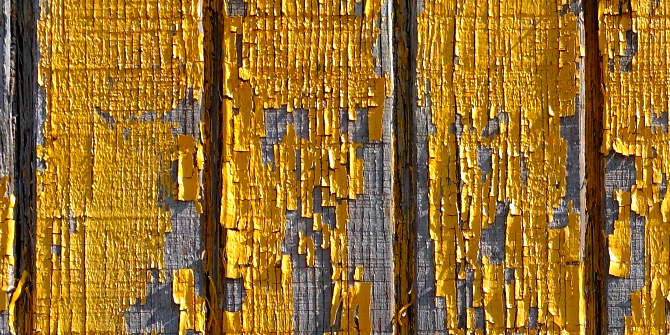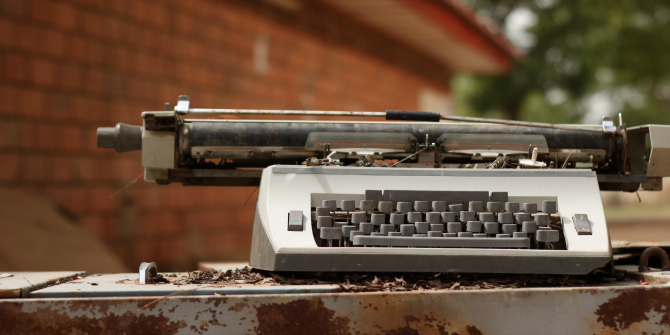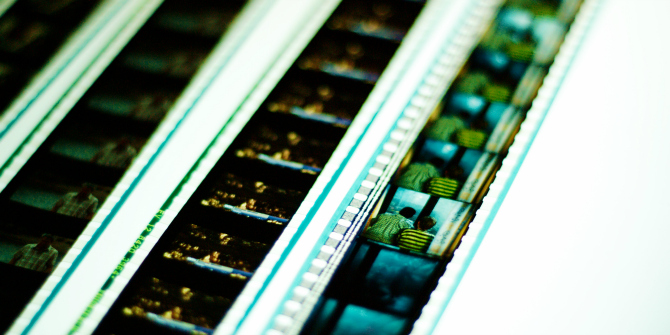In Solvent Form: Art and Destruction, Jared Pappas-Kelley explores the complex relationship between art and destruction, arguing that destruction is an impulse within the interior form of the art object. Drawing on an array of theoretical interventions, examples and anecdotes, this ambitious book would benefit from expanding beyond existing arguments in the literature on art destruction, yet it remains a timely, relevant and thought-provoking read, writes Haythem Guesmi.
Solvent Form: Art and Destruction. Jared Pappas-Kelley. Manchester University Press. 2018.
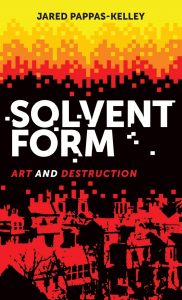 What does it mean when art is destroyed? The complex relationship between art and destruction has been central to many academic and public debates on artworks to the point that one is prompted to suggest that the history of art is the history of its destruction. When Black Lives Matter protesters recently toppled the statue of the slave trader Edward Colston in Bristol, all our ideas about art and its role in politics, culture and social transformation were again revived. In this instance, and others occurring in very different contexts, such as the 2018 auto-destruction of Banksy’s Love is in the Bin and the 2019 Notre Dame Cathedral fire, art emerges as perpetually undoing itself.
What does it mean when art is destroyed? The complex relationship between art and destruction has been central to many academic and public debates on artworks to the point that one is prompted to suggest that the history of art is the history of its destruction. When Black Lives Matter protesters recently toppled the statue of the slave trader Edward Colston in Bristol, all our ideas about art and its role in politics, culture and social transformation were again revived. In this instance, and others occurring in very different contexts, such as the 2018 auto-destruction of Banksy’s Love is in the Bin and the 2019 Notre Dame Cathedral fire, art emerges as perpetually undoing itself.
This undoing process between art and destruction is discussed in Jared Pappas-Kelley’s topical book, Solvent Form: Art and Destruction. He argues that the destruction of art disrupts how a work of art is produced, understood and circulated, and reveals a resonance within the artistic object as being ‘perpetually shipwrecked, undone, and given form through this moment [of destruction] inhabited’ (4). Pappas-Kelley suggests that, similar to a Janus-like figure, the destroyed work of art (and its process of undoing) reveals two impulses at once: one concerns its solvency and the other is about its remainder. It is through the oscillation between ‘destruction’s capacity to create, as well as creation’s capacity to destroy’ (39) that these parallel impulses are revealed. While the topicality of the author’s subject matter and the breadth of his references strongly support such an ambition, Solvent Form suffers from its lack of an expansive discussion of the theoretical issues around this familiar topic.
In the lengthy 50-page introductory chapter, which takes up a third of the book, Pappas-Kelley announces his ambition to engage with the vast scholarship on art and destruction through the exploration of solvency as a revelatory process. He draws on a plethora of well-known examples of the destruction of works of art such as the 2004 Momart warehouse fire, the theft of famous paintings by the art thief Stéphane Breitwieser and their destruction by his mother as well as Jean Tinguely’s self-destroying 1960 sculpture, Homage to New York. Pappas-Kelly departs from the traditional argument regarding the relationship between art and destruction that focuses on the physical and symbolic damage that is inflicted from the outside or as a parlour trick. Instead, he flips this argument on its head to examine destruction as an implied impulse within the interior form of the art object.
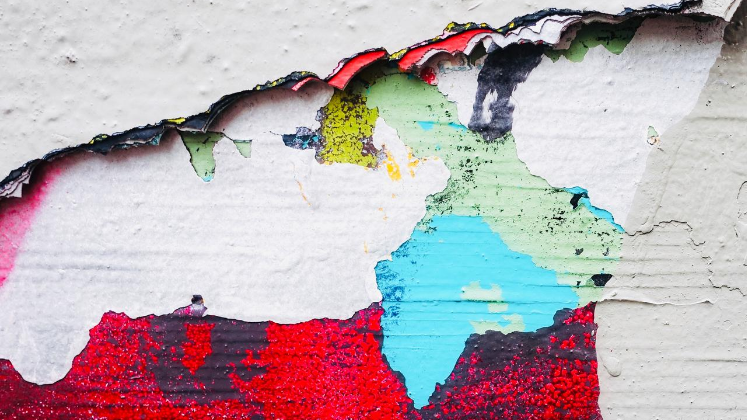
The author takes theoretical inspiration from Georges Bataille’s notion of the ‘negative miracle’ and his argument in The Accursed Share that the presence of an artistic object after its destruction is ‘impossible, and yet there it is’. Bataille’s analogy that ‘like the shipwreck, which is implied with the creation of the ship, there is a similar destruction implied in the art object itself’ is excessively repeated throughout Solvent Form. To illustrate this undoing process from within the art object, Pappas-Kelley also heavily relies on the many examples of lost and destroyed artworks that the Guardian’s Jonathan Jones has written about, and he frequently quotes at length from Jones’s writings. This marked attention to Bataille’s theory and Jones’s ideas leaves little room for a nuanced engagement with other influential studies, such as Dario Gamboni’s The Destruction of Art. Pappas-Kelley hastily dismisses Gamboni’s nuanced argument on the ambivalent impulses within art objects and their reception, only to acknowledge their affinities at the end of the book.
In Chapter Two, ‘Art and Permeable Moments’, Pappas-Kelley defines art by paraphrasing Jean-Luc Nancy’s concept of the image and his analysis of the function of the portrait, or the image in general, and how it captures and endlessly recaptures a moment of fissure between the disappearance of what is represented and the continuity of what is distinct. The tension between these two impulses empowers the permeability of external and internal forms of art and allows the crossing between loss and remainder. As such, the destruction of the art object reveals what has been obscured, what Theodor Adorno calls ‘the truth of art’, and ensnares us in the primary experience of perception.
In Chapter Three, ‘Solvent Form’, the author further develops his understanding of the permeability of the art form through the double meaning of the word ‘solvency’ and how it illuminates the unstable interplay within art between the securing of its exterior form and the undoing of its internal form. The profusion or erasure of form, whether desired or not, reveals the perpetual undoing of what appears as fixed. For instance, Pappas-Kelly examines the examples of Scheherazade in One Thousand and One Nights, who expands the story she tells the king to postpone her execution and cross beyond the rigidity of the imposed time constraint; Sarah Winchester, who endeavours to build endless rooms and hallways in her ‘Mystery House’ to forestall what haunts her; and the visual artist Urs Fischer who melts away a series of full-scale wax replicas by burning them down with candles. These are all instances of how creation itself carries its destruction, and within it, the perception of the moment of fissure reveals the otherness and intimacy of the art object.
In the following chapter, the author continues to elucidate this conception of the destroyed artwork by highlighting that ‘the art object houses a negation in striving to be something it is incapable of’ (90). Highly theoretical, the conceptual meditations in this section of the book are at odds with the more accessible and readable analysis in the other chapters. Pappas-Kelley sees in the commodification of art through exclusionary storage and museumification a turning of the art object into a fixed thing. Attempting to secure art as commodified objects negates the sacred impulse of art. What was revealed, then, when artwork was destroyed in the Momart fire is the instability of art, its intrinsic action of negation of all forms of utility and continuity, and its capacity to be always shifting into and opening onto otherness. Here, Pappas-Kelley’s analysis appears on many occasions to be similar to that of Adorno’s on the negative identity of nonidentity and art’s power of resistance. It is a surprising absence, since Solvent Form would have benefitted from an engagement with Adorno’s arguments on negative aesthetics.
The ambivalent impulses that shape the relationship between art and destruction are again summarised in the last chapter and in the epilogue. We are reminded that the external form of the art object carries a deceptive materiality that attempts to conceal the loss of the unfolding moment within its internal form, and it is only through destruction that the artwork becomes resistant to foreclosure and permeable to otherness.
At the end of his book, Pappas-Kelley confesses that ‘what might all this look like—I have no idea, but I see it and it is burning’ (126). He succeeds in weaving together theoretical interventions from prominent figures such as Bataille and Nancy with a wide array of examples and anecdotes from various artistic disciplines to make Solvent Form a thought-provoking read for undergraduate and postgraduate students. However, the author rarely moves beyond the stage of contextualising and paraphrasing the main arguments in the major works on the topic of art destruction, and the reader is often left with the strong impression that the book does not fully deliver on its promises. Nonetheless, Pappas-Kelley’s first book remains timely and relevant reading.
Note: This review gives the views of the author, and not the position of the LSE Review of Books blog, or of the London School of Economics.
Image Credit: (Edna Winti CC BY 2.0).



